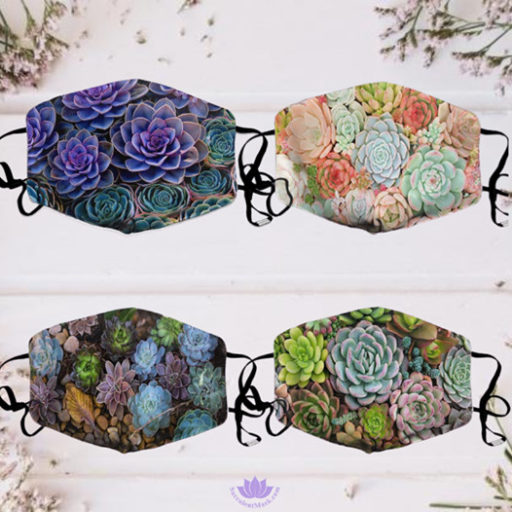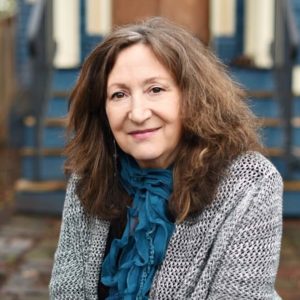In early September, I flew to Newark, New Jersey, to spend my father’s 94th birthday with him. I hadn’t seen him in nine months, a first, and another first, flying during COVID. Surreal: a security line that took all of two minutes, passengers loitering as usual at the departure gate, six feet apart. Those typical plane interactions—do you want ice with that Sprite? Can you sit down through this turbulence?—spoken through masks. No food available on the plane, though flight attendants threw at us little packets of neon-orange cheese crackers.
It all felt strange, but as I looked around, I liked absorbing the individuality of the masks: Princess Jasmine on a shy little girl, gingham and lace on one woman, blue and orange Mets masks. And of course, masks like mine, basic black, a bit of brass-tacks attitude. I felt a connection if I bothered to look: maybe you can’t see my face, people, but here is what matters to me, what I find beautiful, or funny, or just expressive of who I am.
In my book, Entangled Objects: A Novel in Quantum Parts, newly out from Slant, I write the lives of three very different women—an adjunct professor whose spouse tries to clone human cells; a maid who becomes obsessed with prosperity gospel; a reality star.
Ironically, I found these women and began to explore them on a plane, a flight home from South Korea, in that strange twilight place that we who cannot sleep on planes go to. I scribbled the start of my character Fan thinking of a real Korean cloning scandal, a story that in my twilit head became the tale of a man who gets caught faking and his spouse, who becomes immersed in an affair. My Filomena came about because I had seen a man nearly crush a woman’s foot as he fell out of an elevator. Finally, I had Cate, a reality star who looks at her altered face and body and wonders whether or not she is real.
These women put themselves together in my mind, though I sensed they did not, and mostly would not, know each other. As I continued to explore their stories, I realized that they existed in the human equivalent of quantum entanglement—their actions and thoughts changed one another, though they live, until the end of the book, separate lives.
Entanglement is a fascinating, mysterious, thing in physics. Entangled particles can be galaxies apart, yet they change each other’s states instantaneously, in spite of the fact that a signal between them might take millennia to arrive. You can think of entangled particles as those twins who simultaneously pick up the phone to call each other, if you can imagine the twins always picking up the phone at the same time. My characters move through different orbits, but they share “states”: questions of what is real, of what constitutes authenticity in a difficult world, of how we feed our spirits. As each acts and changes, the others do as well, but in the quantum way: a simultaneous connection, with different results.
I wrote this novel at a time before COVID, before the heartbreak of the events that have made the Black Lives Matter protests so urgent, before the heat of the current election. These days have held much tragedy, yet I find the concept of entanglement even richer now. We spend our days with others who are few in number, if we have anyone at all. The kinds of connections we once made each day—at social events, winding through a line at a Starbucks, talking to that person with the adorable little terrier—aren’t happening.
One day during our visit my father mentioned our old landlord, the man who rented an apartment to us in Elizabeth, New Jersey. He was a kind man who had probably forgiven us a few late checks along the way. He had a concentration camp tattoo—a number—on his arm. Two close friends of my family had these tattoos as well; both had been held in Auschwitz. Many Jewish refugees ended up on this odd little street in Elizabeth, a neighborhood of front porch gossip with nail polish and stogies, a cemetery across the street, closely guarded children shrieking up and down.
Like most things we encounter when we’re little, these tattoos didn’t call out to me for an explanation. They just were. Not too different from any other tattoos, whether those were anchors or skewered hearts. Their numbers were rough, like jailhouse tattoos, or something written by a heavy Magic Marker, an analogy that may have occurred to me at the time.
No one told us kids what these numbers represented. It would have overwhelmed any child. But as I grew, my father let me know that these tattoos represented a horrible thing one group of people had done to another, and that someday I would understand it, and I would understand it so I could be a part of it never happening again.
My father was smart enough not to try to tell me more than I could take in. And he was also smart enough to stress that someday I would have to take it in. There was an entanglement here, not yet articulated to me but one that would be essential, would spin and change me. I needed to let it. This history cut deeply into my very bones.
Much later I visited the Yad Vashem Holocaust Museum in Jerusalem, and when I went in, I saw a photograph of a family of transported Jews. One little girl looked exactly like my childhood best friend, Bonnie. I’m not sure what connection Bonnie’s family may or may not have had with the Holocaust. But the gut-punch that she could have died, had her age and circumstances been different, left me crying for quite a while in the Yad Vashem’s restroom.
To survive I think we must embrace our entanglements. We must force ourselves to be changed through the irresistible movements of those who are not close to us in physical space. This is doubly true in this moment of isolation and communal pain. It’s tempting to try to turn away from the bad news, but we can’t. We are spun toward it. Entanglement is very literally a universal truth.
Susanne Paola Antonetta is the author of Make Me a Mother, Curious Atoms, Body Toxic, A Mind Apart, the novella Stolen Moments, and four books of poetry. Her awards include a Library Journal Best Science Book of the Year, a New York Times Notable Book, and an American Book Award. Her work has appeared in the New York Times, The Washington Post, Orion, The New Republic, and many other journals and anthologies.


